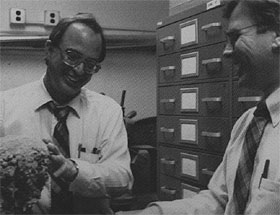Interview: William Schopf

What do mountain climbing and rock collecting have to do with biology? Bill Schopf, a geologist in the Department of Earth and Space Sciences at the University of California, Los Angeles (UCLA), has reshaped our understanding of the history of life by studying ancient rocks called stromatolites. Dr. Schopf was among the first to identify Precambrian fossils of bacteria and cyanobacteria in the layers of sediment that make up stromatolites, some of which were formed by the microorganisms over 3.5 billion years ago. His work has revealed much about Earth's earliest known organisms and the primeval environment they inhabited. Dr. Schopf's research has also led to more informed speculation about the origin of life.
Dividing his research time between the field and laboratory, Dr. Schopf has traveled to some of the most remote parts of the world in his search for rocks bearing evidence of life's earliest era. His discoveries and enthusiastic collaboration with other researchers have made him a prominent figure in local and international organizations devoted to the study of early life and evolution. Even with these commitments, Dr. Schopf remains very involved with students, teaching undergraduate courses in paleontology, paleobotany, and the history of life, as well as graduate-level seminars. Professor Schopf views undergraduate science courses as integral parts of a liberal arts education, a value that is apparent in this interview.
We're sitting with you in the offices of the Center for the Study of Evolution and the Origin of Life. Could you tell us about the center?
This is an interdisciplinary center on the UCLA campus made up of about 120 people, most of whom are UCLA faculty members, though some are from outside the school. We have representatives from chemistry, biochemistry, microbiology, earth and space sciences, atmospheric sciences, anthropology, biology, and a number of folks from the medical school. Unlike our universities, nature is not compartmentalized into various departments. The natural sciences have no real boundaries; if you want to question one aspect of science, you really must be educated in ancillary disciplines. We come together once a week for dinner and discussion about a broad array of evolutionary problems: the evolution of the universe, the evolution of life, the origin of Homo sapiens,, and musings about extraterrestrial life and future evolution. When it's my turn to provide dinner, we have Kentucky Fried Chicken.
How did you first become interested in science generally and then more specifically in paleobiology?
Well, my father was a paleobotanist and I was always involved with science as a young boy. My father, like many scientists, worked seven days a week. Sometimes he'd have the responsibility of looking after my brother and me; he'd take the two of us down to the laboratory and assign us tasks to do, which mostly I hated. But I got introduced to the university and to science very early that way. I was always interested in things having to do with evolution.
My professional interests started when I went to Oberlin College in Ohio. Initially I thought I might be a philosophy major, but I maintained my interest in the sciences. When I was a sophomore in college, a professor in a beginning geology course gave a lecture in which he pointed out that essentially nothing was known about the organisms that were around during the Precambrian era, the earliest seven-eighths of Earth history. Although he only mentioned this briefly, for some reason it struck me as really interesting. I didn't quite understand why there wasn't a fossil record earlier than the base of the Cambrian period (550 to 600 million years ago). I had a copy of Darwin's On During that same period, I also read a book by George Gaylord Simpson written in 1949, in which he pointed out that the evolutionary distance between man and amoeba ought to be about the same as between an amoeba and the origin of life. And since he thought amoebas might have been around 500 million years ago, he thought that life originated about a billion years ago. I remember thinking that there is no way he could say such a thing, because there were no data. I thought that there ought to be some evidence, and so I became very interested in the problem and thought this might be a good thing to study in graduate school.
Bill Chaloner, who is a very distinguished paleobotanist in England, was visiting my father one summer and I remember talking to him about my plans. He said, "Look, you're a nice young boy. Don't waste your time on that ... it won't be successful." He has since told me that he tells this story to his beginning botany students in London to point out that he's not always right. The fact is that I was lucky. I thought that this would be an interesting thing to do. I could have been absolutely wrong and had no success at all. But I was young and I didn't know any better. It happened that I was fortunate and Darwin was right. There is an early fossil record, and I've had a lot of fun trying to find out about it.
People had been looking for a hundred years for evidence of life before the Cambrian period. What was the key to your discovery?
Well, people were just asking the wrong questions, looking at the wrong rocks, and not really understanding the problem. They had approached the question of the early history of life using the strategy for finding evidence of life in the younger geologic record, namely, tromping across a bunch of rocks out in the field, looking down, and picking up whatever you see. The problem with this method is that the Precambrian era was the age of microscopic life and there are no large body fossils of that sort except at the very end of the Precambrian. The strategy that has paid off really dates back to World War II, when oil companies first started to use the science of palynology. This is the study of fossil plant spores and pollens accomplished by dissolving rocks in mineral acids. A Soviet named Vologdin started applying this technique to Precambrian rocks and had been reporting results in the Soviet literature. But for various reasons, mostly political I think, and also because of language difficulties, the rest of the world, particularly North Americans, didn't read the Soviet literature.
Then came along an economic geologist, Stanley Tyler, at the University of Wisconsin, who in 1953 was doing geological work on the northern shore of Lake Superior in connection with mining companies looking for iron ores. He happened to pick up some rocks, which later turned out to have microscopic fossils from a deposit called the Gunflint Iron Formation. He thought these were probably fossils, but being an economic geologist, not a paleontologist, he wasn't really sure. In 1953, he came to the Geological Society of America meetings, which were held in Boston that year. He had some pictures of these fossils, which he pulled out of his jacket pocket and showed to Elso Barghoorn, a well-known paleobotanist. Barghoorn recognized the beasts and the two of them wrote a paper in 1954. I showed up as a graduate student in Barghoorn's lab at Harvard in 1963 when this thing was just starting to break.
What is the vintage of the oldest known fossils and what do they look like?
The oldest fossils that have been found so far are roughly 3.5 billion years in age, 3,500 million years old. They come from Western Australia. They are only a few micrometers in diameter so you cannot see them without a microscope. Normally, you study them with the highest-power optical microscope available. They are chains of small cells that look rather like spherical beads on a string. Each one of those beads was a living cell. So they're really colonies of primitive organisms, probably closely related to modern bacteria and, I think, cyanobacteria.
How do you know where to look for these fossils?
Well, thanks to the hard work of field geologists who determine the distribution, nature, and ages of rocks all over the world, scientists like myself know where all of the ancient rocks are. The minute microscopic cells that I look for are very delicate so I want to find not only old rocks, but rocks that have not been heated or subjected to mountain-building processes that could have destroyed the little delicate cells. So you read the existing literature to find out where the good hunting places are. Then you go out, using maps, to collect the rocks, bring them back to the laboratory, and study them.
What are stromatolites?
Stromatolites are mound-shaped objects. Sometimes they're flat, sometimes they're crinkly, sometimes they look like cabbage heads. They vary in size from very small, about the diameter of a pencil, to great big ones that can be as large as a football field. Characteristically, they are made up of layer upon layer of fine rock, each layer about a millimeter in thickness. The layers were formed by, and in fact reflect the presence of, communities of many different types of microscopic organisms. The communities built up these layered masses, often over long periods of time. If the stromatolites are being formed by organisms in an area where they can become mineralized, particularly with the mineral calcite (calcium carbonate, the stuff of which limestone is made), then the stromatolites can be preserved in the geological record. The stromatolites then represent evidence of diverse communities of microscopic organisms that once lived where the stromatolites are now found.
If the oldest fossils are about 3.5 billion years old, then how much earlier did life first arise on earth?
I'm often asked that question, and I'm afraid that my answer is, I don't know. In fact, no one knows. The two relevant facts here are, one, that the oldest fossils are about 3.5 billion years of age and, two, the planet is about 4.5 billion years of age. So the time span in question is somewhere between 4.5 and 3.5 billion years ago. But within that 1-billion-year period, when did life originate? The answer to that becomes what is called a guess, which is a whole lot different from a scientific statement. All one can do is to extrapolate. We have some knowledge about how fast organisms evolved from 3.5 to 2.5 billion years ago. If that same rate occurred earlier, then how far back might life be traced? The answer, with some sort of a guess, is that it is at least plausible to think that life on Earth might have originated as early as 4 billion or 4.2 billion years ago. That is pretty soon after the origin of the planet. The interesting corollary to that is that life would seem to be pretty easy to start up. If it happened here relatively rapidly, it might happen elsewhere relatively rapidly, and there might be lots of life throughout the rest of the universe.
What do you think Earth looked like at that time? What type of environment do you think the first cells took form in?
Well, once again, there is a real difference between speculation and fact. We have well-preserved geological sequences of rocks that are 3.5 billion years of age. The rock record tells us that there were liquid water oceans, tides, shallow water environments, and volcanoes. We can paint a reasonably accurate picture of what the Earth looked like at that time.
Unfortunately, only one sequence of rocks is older than 3.5 billion years. It is a sequence from southwestern Greenland that is about 3.8 billion years old. But that set of rocks has been very highly altered by heat and pressure (a thing we call metamorphism). So it's a little hard to interpret just what they tell us. One thing that this sequence tells us is that there was liquid water on our planet 3.8 billion years ago. Therefore, the surface of the earth at that time was warmer than 0°C and cooler than 100°C. That's the range at which life exists well today.
There certainly were volcanoes. Remember, the Earth had formed a few hundred million years earlier, and there's a lot of heat in that process. Meteorites smash into the surface of the Earth and get buried; a lot of kinetic energy (heat) is buried with these meteorites. The heat is released by melting rocks, which give off gases. Atmospheric nitrogen and carbon dioxide, as well as the oceans, come from the gases released during these processes. So you can image that the early Earth had volcanic cones, water condensing out of the sky, carbon dioxide, some nitrogen, and some argon in small amounts. There were shallow seas and probably deeper seas. But it took a very long time for the Earth to begin to look like it does now with such large continental masses.
Do you believe that you or your colleagues will ever find fossils of organisms much older than 3.5 billion years old?
The techniques that we're using are good only to detect organisms with cell walls. Since the absolutely first living thing was a lot more like an oil droplet, something that wasn't enclosed by a physically resilient wall, it's well near impossible for us to find that sort of life. Once organisms get cell walls, then we have a chance to find them. And then the only thing that limits us is the available rock record.
How do you think the earliest bacteria nourished themselves?
There is a fair amount of debate on that question. The approach used is to look at the physiology, the metabolism, and the biochemistry of modern organisms, living descendants of the earliest organisms, and try to determine from them what the earliest organisms were like.
A rather famous book, a little pamphlet published in 1922 by a Soviet biochemist named Alexander Oparin, sets the stage for current thought regarding the origin of life. He was one of the first to theorize that the earliest forms of life were probably anaerobic: that is, that they lived in the absence of oxygen. He speculated that they derived energy by metabolizing organic matter derived from nonbiological processes. The notion is that small organic compounds were synthesized by an electrical discharge, lightning, in a primitive atmosphere without much oxygen. The organisms evolved from that primordial soup and then, in turn, were able to metabolize it. Of course, Stanley Miller demonstrated this in the laboratory and showed that Oparin's idea was right.
In 1976, Oparin, who was by then an elderly man, spent three months here in my lab at UCLA as a visiting scientist. He told us a story that has always impressed me and is worth passing on here. In 1915, at the time he was graduating from high school, Oparin was selected to attend Moscow State University. When visiting the school, he had time to attend only one lecture. Having come from the countryside, he decided to sit in on a botany lecture by a man named Timirjazev, who at that time was the leading Russian botanist of his generation and a leading evolutionist.
In his lecture, Timirjazev told a story about how he had become interested in evolution. When he was a student, Timirjazev had traveled to England in an attempt to meet Charles Darwin. This was about 1870 or 1880, 15 to 20 years after the publication of The Origin of Species. Darwin was old and often in ill health and unable to receive visitors. Every day Timirjazev went to sit on the front steps outside of Down House (Darwin's home), hoping that he, a young man, would have an opportunity to meet the great Charles Darwin. Well, after doing that for four to five days, Darwin came out to meet him. The two of them spent two afternoons walking the sand path behind Darwin's home. Darwin told the young Timirjazev what he thought about evolution and about the evolution of plants.
So, Timirjazev goes back to Moscow, becomes a very famous professor, and when he is about 80 years old, meets the young Oparin. He tells Oparin this story, which is the first time that Oparin has heard much about evolution. Oparin gets absolutely enamored with the idea, and he notes that the thing that Darwin didn't deal with was the problem of the origin of life. So, sure enough, Oparin says, By golly, that looks like a good thing for me to worry about!
By 1918, Oparin had written a 15-page manuscript, which he submitted for publication, outlining his theory of the origin of life. Well, it got turned down. In the time of the czars, the Russian Orthodox church had a set of censors that wouldn't permit publications that were not in line with what the czar deemed appropriate. Even though this was a year after the revolution, the censors had not yet been removed from power. So, when Oparin submitted his paper, the censor felt that Oparin's notion about the origin was not consistent with current theological doctrine and rejected it.
Oparin said that was a great thing for him, because he spent the next four years on this theory and put together what he always called, affectionately, his little pamphlet. He resubmitted it in 1921; it was published in 1922 and then finally translated into English in 1938. Oparin's pamphlet formed the framework for all current thinking on the subject.
And now we come to 1976, when Oparin was visiting my lab. He recounted this anecdote to me and about two dozen of my students sitting around having lunch one day. To me, this entire story shows the remarkable continuity in human science. It illustrates the lineal descent from Darwin to Timirjazev, from Timirjazev to Oparin, and from Oparin to my students. In a hundred and some years of human history, you have this remarkable continuity of the human process of science.
Of all your discoveries, what has most surprised you?
I suppose what surprises me most is how often I'm wrong! As a sophomore in college, I intended to trace back the history of life to a billion years and then, based on the geological evidence, investigate the origin of life itself. I thought that if I went back far enough, I'd run out of fossils, and then I could find evidence of the primordial soup that Oparin and Miller postulated. The big surprise is what a very naive notion this was. Who would have thought that for 80% of the history of life, our whole planet was dominated by microscopic organisms? Another big surprise is that the rate of morphological change is so much slower in microbes than in higher organisms. Cyanobacteria, prokaryotes in general, don't evolve very rapidly morphologically. Their big evolutionary changes happen at the biochemical level.
How often do you take field trips to collect rocks? Where do you go and for how long?
Well, I take field trips whenever I get the opportunity. It really depends on the stage of development of a given project. I do a lot of laboratory work too. I'm very lucky to have the opportunity to travel widely because the rocks that I look for don't occur just everywhere. The older the rock is, the greater the chance that it no longer exists. So, as you go back through the geological record, there are fewer and fewer rocks for you to study. It happens that the rocks I look for are in rather interesting places: Western Australia, South Africa, portions of China, Siberia, the Soviet Union.
Is it dangerous?
That depends on where you're working. Western Australia is hot, arid, and fairly desolate. You can get into some mountain-climbing predicaments that are a bit scary. I got into a situation in Western Australia on a ledge a couple of feet or so in width. I made the mistake of looking down, and there was about a thousand-foot drop directly beneath me. My knees turned to jelly. It was awful. And once a good friend of mine at the University of New Mexico was on a field trip in arctic Canada. They were left off near the summit of a mountain by helicopter and were supposed to hike down. He lost his footing and slid down the side of a huge snowfield. Luckily, two members of the party below were able to stop him before he went over the edge. He's very experienced; he just lost his footing.
For the most part, it's just dirty, dusty, hard work. But the fact is that you learn a great deal in the field that you simply cannot learn in the laboratory. If someone just gives you a specimen of rock in the lab, you can't tell much about the environment from which it came. If you study the rocks laterally and vertically in the field, you can tell how deep the ocean or the lagoon was in which these rocks were formed. You can see how the environment might have changed over time and you can speculate on what sort of organisms you might expect to find.
What do you do with the rocks once you have them back in the lab?
Mundane as it may sound, it is exceptionally important to make sure that the rocks are labeled properly. Unless you curate a piece of rock properly, it is no good to anyone. You might as well use it as a doorstop.
Typically we divide the rock into various fractions. One portion will be ground to a very fine powder, which we'll subject to chemical studies. The chemistry of the organic matter will tell us something about the organisms that were there. Another piece of rock will be dissolved in acid, and the bits of organic matter remaining will be examined under a microscope to see if there are any minute cells preserved. Another portion of that rock will be sliced very thinly and then ground until it is about the thickness of a piece of paper, thin enough to see through. We will study the slice under a microscope and, if we are fortunate, we will see the fossils of cells that were living at the time.
What is your advice to students who think they would enjoy the detective work of tracing the history of life?
Well, I think I'd like to offer encouragement rather than advice. First of all, it's fun. It's also a lot of work. It's tremendously rewarding to find something that nobody else has ever seen. In my particular area, that happens rather frequently. You might find something that will change a generalization or will change the ideas that go into a beginning biology textbook. Then you feel like you've contributed to the understanding of the world in which we live.
In terms of preparation, I would like to come back to this notion that nature is not compartmentalized. I encourage students at an early stage in their careers to take courses in as many of the related sciences as they can. There is a certain vocabulary associated with any area of science, whether it be physics, geology, mathematics, chemistry, or biology. If you don't learn all these terms early, then you never will. If you never learn the vocabulary, you'll never read the literature. Then you won't understand the framework of that field, and you won't be able to address the questions that involve that field. Only if you educate yourself in several areas of science will you have a chance to make a particular contribution to human knowledge. That's what I'd encourage students to do.



©2005 Pearson Education, Inc., publishing as Benjamin Cummings